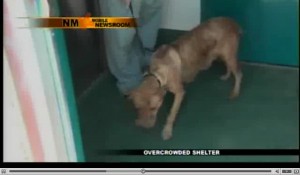No man ever steps in the same river twice, for it’s not the same river and he’s not the same man.
~Heraclitus
Redemption, the book that kicked the No Kill movement into high gear when it was published in 2007, opens with a description of a public execution of animals by a shelter director in California in the early 1990s. Over twenty years after that dark day, just over ten years after the birth of the first No Kill community, and almost four years after the publication of Redemption, a New Mexico shelter director pulled the same despicable publicity stunt.*
Redemption begins:
As director of the little known Peninsula Humane Society in San Mateo, California, Kim Sturla oversaw an animal shelter that took in thousands of dogs and cats every year, the majority of whom were put to death. Her record was hardly impressive. But on October 27, 1990, reporters from across the nation converged upon a small room in her shelter, and she had their full and rapt attention.
While cameras clicked and onlookers gasped, Sturla took a tan-and-gray calico cat and her four tiger-striped kittens–all healthy, adoptable animals–and injected them in the stomach with poison from a bottle marked “Fatal Plus.” One by one, their tiny bodies went limp and they slumped on the table. By the time she had finished, Sturla had killed eight animals, five cats and three dogs on television. Dubbed a “public execution,” the first-of-its-kind public relations ploy was an instant sensation.
People for the Ethical Treatment of Animals (PETA), and organization whose hard-line advocacy on behalf of animals is legendary, should have decried the killings. At least, that is the reaction one would expect–and hope for–when animals are killed as a public relations gimmick. But it didn’t happen. PETA, in fact, labeled the acts “courageous.”
I remember reading about that incident in the New York Times when I was in college. I remember feeling sick and speechless that anyone would do that, and that people would take pictures rather than intervene. It was just so warped, so creepy. How could anyone feel good about this? How could anyone celebrate it? How could anyone not feel some combination of dirty and angry that this was allowed to happen, that it was endorsed by even one organization that was supposed to protect animals? Some things cross the line. Some things don’t make you a bigger journalist, though they lessen your humanity. There was a room full of people who could have adopted those animals on the spot. Why didn’t they?
That same article I read all those years ago is now available on the internet. “San Mateo Journal; A Crusade to Save Unwanted Lives” starts with:
The dog in her arms was shaking, its rheumy eyes wide with fear.
“Just relax, sweetheart, it’s O.K.,” crooned Chris Powell, the manager of the Peninsula Humane Society animal shelter, where 10,000 unwanted pets are put to death each year.
And ends:
Last week, the shelter bought advertising inserts in three local newspapers, and 178,000 families on the peninsula south of San Francisco looked at pictures of trash barrels full of dead cats along with their morning coffee.
Then, reporters and television crews were invited to witness what one newspaper called a “public execution” of four kittens, a cat and three dogs. One reporter cried, another began adoption proceedings and a third left the room because the dog being killed resembled one he once owned.
The shelter has received many “How dare you!” telephone calls, but Ms. Sturla said she was unrepentant.
“You have to see it to experience the immorality of it,” she said. “We tried to tell the public with numbers, but it didn’t work. It’s time to take a 2-by-4 and hit them over the head.”
In between is quite the irony sandwich. I’ll just take a deep breath and think of the “Crusade to Save Unwanted Lives” line as one of those frilly toothpicks.

This golden-haired dog, a new mother was killed on camera by a shelter in NM. Remember her. She was an individual and her life had meaning. It was all she had and the people who were supposed to protect her took it away out of ego and incompetence.
I suppose that if your only tools are syringe full of “Fatal Plus” and the proverbial “2-by-4″, then animals and people all start to look like they should either be getting an injection or getting whacked over the head. Those of us who fought for change in Tompkins County got beaten bloody with that 2-by-4. We’ll never forget that. We’re not the same people we once were.
The July 6, 2011 article from New Mexico, titled “Too Many Animals Crowding Shelter”, starts:
Too expensive, unwanted or forgotten are among endless excuses contributing to the highest intake a Las Cruces animal shelter has ever seen.
Dr. Beth Vesco-Mock, director of the Animal Services Center of the Mesilla Valley, says the euthanasia rate is skyrocketing.
And, in the spirit of fighting fire with fire straw men with lame excuses while proclaiming your inability to do even a halfway decent job, ends:
Inside a small room with a metal table, Herring shaved the fur off part of her paw. Another man, held her in his arms. For this brief moment, she is not alone. Then there is a quick injection, and her final breath. Her final resting place is a black garbage bag stuffed in a freezer.
“It’s heartbreaking, definitely, when you think about your own animals that you have at home that you love and you’re caring for, and then you see the way people throw these away like garbage,” Herring said. “They throw it on us, saying, ‘Well we’re leaving the dog with you, it’s your decision,’ and it’s not our decision because you’re the one who is burdening our shelter with this animal knowing we don’t have the space for it.”
Vesco-Mock says she does believe this could change, but says it will not change until the community takes a serious look at education for how to responsibly care for a pet.
“I’m sure the public is tired of hearing this problem but unfortunately, it is a community problem – it is not a shelter problem,” Vesco-Mock said.
And they say that with a straight face, a 70% kill rate, and this as their mission statement:
The Mission of the Animal Service Center of the Mesilla Valley is to provide safe shelter for all lost, mistreated, and abandoned animals of the Mesilla Valley and surrounding communities. The Center utilizes all avenues available to it in placing each animal into a safe, loving, and permanent home whenever possible. We strive to meet the highest standards of humane animal care and husbandry, and to promote responsible pet ownership through public education and outreach.
It is a bit old, this use of public killing, ostensibly to sell ideas that have never gotten lifesaving results. And, under the circumstances, the statements they make about the public are of questionable credibility. The pound staff can be reached here. The mayor can be reached here.
But is it the New Mexico public execution the same despicable publicity stunt after all that has happened in the intervening years? How could it be? Have the people running ‘shelters’ learned anything in the past 20 years?
Timeline:
Ed Duvin published “In the name of mercy” in 1989. Many believe that this article marks the start of the No Kill movement. It set off such a firestorm of controversy that shelter directors everywhere, including Kim Sturla, must certainly have been aware of it when she orchestrated her 1990 publicity stunt.
The San Francisco SPCA, under the leadership of Richard Avanzino began spearheading the practical application of No Kill ideals, including foster care and offsite adoptions. These things which are familiar were once, incredibly, controversial. In 1989, it got rid of its costly animal control contract. In 1994, with the Adoption Pact, it began saving all of the city’s healthy animals and dramatically reduced the killing of treatable animals, but, after a disastrous change in leadership, the SFSPCA went from inspiration to cautionary tale.
Tompkins County, NY became the first No Kill community in the United States in 2001. It recently celebrated 10 years of saving every healthy or treatable homeless pet that came through its open doors. Nobody could truthfully say that No Kill communities were an impossible dream anymore.
Charlottesville, VA became the second No Kill community in the US in 2006 under the leadership of Susanne Kogut.
Reno, NV followed in 2007, under the leadership of Bonney Brown and Mitch Schneider.
Redemption was published in 2007, providing many people with the knowledge and inspiration they needed. The word is out. It’s been out for years. Anyone who hasn’t read it and taken its message to heart has no business running an animal shelter.
The ’90% Club’ continues to grow, and each new member has its own inspiring story.
No Kill advocacy groups are proliferating, and they’re using social media to further accelerate change. Among them is New Mexico Pets Alive, which invites concerned citizens to their meeting next week.
Thanks to social media, the word is out. We’re not so isolated any more. Times have changed. Where Kim Sturla had the luxury of remaining unrepentant and keeping her job 20 years ago, her counterpart, Dr. Beth Vesco-Mock will face an increasingly organized and savvy force of No Kill advocates, people who are constantly learning, and who will do more than just annoy her with a few “‘how dare you’ phone calls.” They will fight until she is replaced with a shelter director committed to the No Kill Equation.
This river’s not slowing down anytime soon.
Sink or swim.
UPDATE, 7/11/11: New Mexico Pets Alive! has issued a formal response to the televised killing of a shelter dog last week. You can read it here. The letter (which is excellent) includes contact information for the mayor (who is apparently sympathetic to NMPA’s position) and to others in authority. It also reveals that this is the second time this ‘shelter’ director has killed an animal as a publicity stunt. Argh! Hint: when you’re doing stuff like this, the third time is not the charm.
UPDATE, 7/13/11: Apparently Dr. Vesco-Mock once directed a Georgia shelter, but was fired after 6 months, on the heels of an incident in which an impounded dog was kept in a hot animal control vehicle and died as a result. Article here.
*Note that this link goes to a video which depicts the killing of the dog pictured here and an accompanying article. I do not recommend watching the video. Unlike Ms. Sturla, I believe that the immorality of this whole sordid story is quite evident to any normal person.










